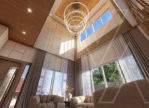House Design Tips For Bicol Home Owners

2020 taught Bicolanos two very crucial lessons. First, they need to be ready for any eventualities, say, a global pandemic and second, they need to have typhoon-proof homes to survive a series of strong storms in a span of three weeks. For COVID19, there are only a few things you can do to prepare for that. For typhoon-proofing homes, Bicolanos might just have a lot of options to make sure their homes can withstand the reality of global warming (yes, stronger storms).
So what are some house design elements that can be applied that can make a structure stronger against Signal No. 4 – 5 winds? Here are Vesta’s inputs:
Stronger windows and storm shutters
You can have your house designed so that storm shutters are already built into it. No more spending hours doing temporary solutions like boarding up your windows using nails and boards that can end up ruining your walls and window frames and still not strong enough to resist the winds when it does come.
Aside from shutters, you can also make sure to have storm-ready window materials. Louvres are a better option, so are laminated tempered glass, although these could be more expensive than just having storm shutters built in.
Go for the four-sided slope roof
The four-sided slope design roof with a rectangular base can lessen the impact of the wind pressure while ensuring that the structure remains strong over time, through multiple storms. It is best that this roof design is complimented with a minimized canopy design or lessened eaves (better to avoid it altogether).
Eaves or overhangs allow the winds to have a hold to the house structure when it goes up from the ground, elevating the risk of the roof being pulled out of its frame. The less you have this, the higher the chance that your house will survive the gusting winds of typhoons, which in the case of Typhoon Rolly, reached up to more than 200 km/h.
Better location
Many homeowners neglect this part of their dream home planning. But this is still one of the most important considerations before even designing a home. We want to include this on our list because we believe that this is still part of the overall sustainability of the house which Vesta is advocating for in all its design projects.
The Philippines has a geo hazard map so it is best to consult that before buying a lot in a certain location. One very obvious thing to watch out for is being prone to flooding. Having a river nearby can mean a risk for flood. Ask around, consult with the neigbors, ask the local government. There are parts in the Bicol region that is known for flooding. Make sure your house is not built there.
It is also important to reconsider building near the sea. There are of course architectural remedies for beach houses to make them sea side worthy and Vesta can provide the expertise regarding this but storm surges, a devastating element in any big typhoon, must be seriously considered in here as well, something that is better prevented than building a solution around it.



